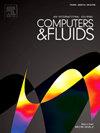Korteweg–De Vries–Burger Equation with Jeffreys’ Wind–Wave Interaction: Blow-Up and Breaking of Soliton-like Solutions in Finite Time
IF 2.5
3区 工程技术
Q3 COMPUTER SCIENCE, INTERDISCIPLINARY APPLICATIONS
引用次数: 0
Abstract
In this study, the evolution of surface water solitary waves under the action of Jeffreys’ wind–wave amplification mechanism in shallow water is analytically investigated. The analytic approach is essential for numerical investigations due to the scale of energy dissipation near coasts. Although many works have been conducted based on the Jeffreys’ approach, only some studies have been carried out on finite depth. We show that nonlinearity, dispersion, and anti-dissipation are the dominating phenomena, obeying an anti-diffusive and fully nonlinear Serre–Green–Naghdi (SGN) equation. Applying an appropriate perturbation method, the current research yields a Korteweg–de Vries–Burger-type equation (KdV-B), combining weak nonlinearity, dispersion, and anti-dissipation. This derivation is novel. We show that the continuous transfer of energy from wind to water results in the growth over time of the KdV-B soliton’s amplitude, velocity, acceleration, and energy, while its effective wavelength decreases. This phenomenon differs from the classical results of Jeffreys’ approach and is due to finite depth. In this study, it is shown that expansion and breaking occur in finite time. These times are calculated and expressed with respect to soliton- and wind-appropriateparameters and values. The obtained values are measurable in experimental facilities. A detailed analysis of the breaking time is conducted with regard to various criteria. By comparing these times to the experimental results, the validity of these criteria are examined.Korteweg-De Vries-Burger方程与Jeffreys的风波相互作用:有限时间内类孤子解的爆破与破裂
本文分析了浅水环境中Jeffreys风浪放大机制作用下的地表水孤立波演化过程。由于海岸附近能量耗散的规模,解析方法在数值研究中是必不可少的。虽然基于Jeffreys的方法进行了许多工作,但只有一些研究是在有限的深度上进行的。我们证明非线性、色散和反耗散是主要现象,服从反扩散和完全非线性Serre-Green-Naghdi (SGN)方程。本研究采用适当的微扰方法,得到了结合弱非线性、色散和抗耗散的Korteweg-de vries - burger型方程(KdV-B)。这个推导是新颖的。我们发现,从风到水的持续能量传递导致KdV-B孤子的振幅、速度、加速度和能量随时间增长,而其有效波长则减少。这种现象不同于Jeffreys方法的经典结果,是由于深度有限。研究表明,膨胀和断裂是在有限时间内发生的。这些时间是根据孤子和风的适当参数和值计算和表示的。所得值可在实验设备上测量。根据各种标准,对断裂时间进行了详细的分析。通过将这些时间与实验结果进行比较,检验了这些准则的有效性。
本文章由计算机程序翻译,如有差异,请以英文原文为准。
求助全文
约1分钟内获得全文
求助全文
来源期刊

Computers & Fluids
物理-计算机:跨学科应用
CiteScore
5.30
自引率
7.10%
发文量
242
审稿时长
10.8 months
期刊介绍:
Computers & Fluids is multidisciplinary. The term ''fluid'' is interpreted in the broadest sense. Hydro- and aerodynamics, high-speed and physical gas dynamics, turbulence and flow stability, multiphase flow, rheology, tribology and fluid-structure interaction are all of interest, provided that computer technique plays a significant role in the associated studies or design methodology.
 求助内容:
求助内容: 应助结果提醒方式:
应助结果提醒方式:


